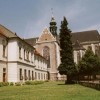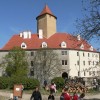Villa Tugendhat underwent major reconstruction over the last two years and from this March it will offer visitors countless new features. Apart from the main living areas visitors will be able to see the unique utility and technical floor housing the engine room of the air distribution system, the “moth-resistant” room for the storage of fur coats and flats for the staff. A brand new research centre will be available for professionals looking to find out more about the unique building. The garden adjacent to the villa has also been fully restored.
Timeless jewel of modern architecture
Villa Tugendhat was designed by renowned German architect Ludwig Miese van der Rohe in 1928 at the request of Fritz Tugendhat, the owner of Brno´s large textile factory. The construction was completed in December 1930. Sadly the family did not have a chance to enjoy the exceptional accommodation located on a mild slope in the Černá Pole (Black Fields) district of Brno. In 1938, after they had been living in the house for a mere eight years, the family emigrated in fear of the Nazis. The villa was confiscated by the Nazis during the war and it was subsequently devastated by the soldiers of the Russian Red Army. After the war the villa served various purposes until the City of Brno took ownership of it in the early 1980´s, partially reconstructed it and started using it for representative purposes and as an accommodation for official guests. In 1992 it witnessed a historical moment when the Prime Ministers Václav Klaus and Vladimír Mečiar signed a treaty agreeing to the splitting of Czechoslovakia into two autonomous countries – The Czech Republic and Slovakia. Villa Tugendhat was listed in 2001 as the Czech Republic´s only modern architecture representative on the UNESCO World Heritage list. The family residence entered the history of architecture not only because of its construction and the layout of the living area but also due to the exceptional technical equipment used for its time including an electric powered window opening system, a sophisticated air-conditioning and a door opening sensor at the entrance. The official re-opening of the villa after the extensive reconstruction will take place on February 29 and the first visitors from the public will be able visit the house on Saturday March 3. Among other things there will be a stunning view of the city to enjoy from its prominent location.
Brno boasts other significant sights
Moravia´s capital is the beating heart of the Region of South Moravia. It has almost 400 000 inhabitants and has plenty to offer to visitors. Built in the 13th century the Royal Castle of Špilberk was turned into a baroque fortress in the 17th and 18th centuries and became the most renowned prison of the Austro-Hungarian Empire. It was famously nicknamed “the prison of the nations“. Today the Castle is the seat of the Museum of the City of Brno with numerous expositions. The Castle is surrounded by an extensive park which offers a lovely view of the city. The second castle of Brno is called Veveří and is set in a beautiful landscape overlooking the Brno Dam. It is a former royal hunting castle and can be visited either on foot or by boat – there is a steam boat berth below the Castle. Those of more adventurous nature can venture into a baroque crypt underneath the Capuchin monastery. The unique system of air circulation in this tomb enables natural mummification of the freely stored corpses. In the Mendl Square there is a unique gothic Cathedral of Ascension of the Virgin Mary which was awarded the title basilica minor from Pope John Paul II in 1987. The oldest non-religious building in Brno is the “Old Townhall” with its well-known crooked tower, which is the subject of various legends, and the famous Brno dragon hanging from its ceiling in the entrance to the tower.
When you get tired of sightseeing
When you have seen all the historical sights Brno has to offer we recommend you visit the beautiful Brno Exhibition Grounds, home to more than 150 trade shows of various industries every year. Your next destination might be the zoological garden located on the slopes of Mniší Mountain in Brno – Bystrc and taking up 65 hectares. You will see more than 200 different species among the 800 animals. The most popular summer spot in the city is Brno Dam where you can just relax or get involved in various sports activities. If you are a lover of motorsports do not forget to visit Masaryk´s Ring which is one of the most modern motor racing circuits in central Europe. You can join a guided tour, go on a test ride or enjoy inline skating on the circuit.
When the night falls
Brno won first place in the Urban Security Award competition last year which it entered with a project called Safe location – safe living. You can therefore feel perfectly safe when you take to the streets at night.
You should definitely pay a visit to one of many local restaurants as Moravian gastronomy is very special. We recommend you wash down the local specialities such as Moravian meat roll, Znojmo goulash or scones from Vlčnov with a glass of white or red Moravian wine. After the tasty dinner you can treat yourself to one of many cultural events. Brno is home to several theatres, concert halls and music clubs offering music of all kinds. It will be an unforgettable experience to listen to traditional Moravian cimbalom music and folk songs.
South Moravia will inspire you
South Moravia is the fourth largest region of the Czech Republic and third largest in terms of the number of inhabitants. It boasts four UNESCO listed sites and is renowned for its attractive folklore tradition and wine tourism. Whichever direction you decide to take in South Moravia you will always be surrounded by things to admire. Don´t forget to visit some of the most beautiful castles in the Czech Republic including Pernštejn, the castles of Lednice and Valtice, the Moravian Carst (caves) or towns such as Znojmo, Hodonín and Strážnice.













 Stará radnice
Stará radnice
















 Gallery / sight-seeing location / museum / mansion / villa / palace
Gallery / sight-seeing location / museum / mansion / villa / palace Information centre
Information centre
 Closed right now, as per business hours
Closed right now, as per business hours









